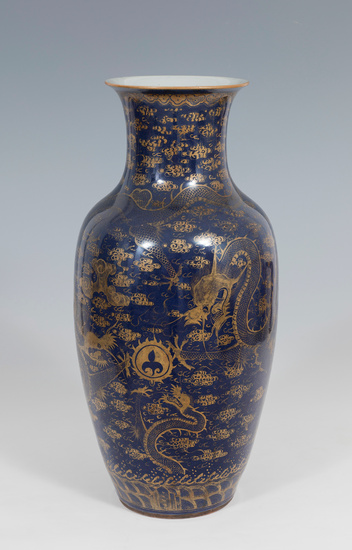Vase; China, Qing Dynasty, Tongzhi Period, 1862- 1874.
Vase; China, Qing Dynasty, Tongzhi Period, 1862- 1874.
Powder-blue porcelain.
It has slight Repainting.
It has a mark on the base.
Measurements: 49 x 21,5 cm (diameter).
The dedication on the base of this piece indicates that it is a work conceived as a gift for the patriarch of the family. Ornamentally the vase features three golden dragons in search of the pearl of wisdom, with ruyi clouds completing the ornamental pattern. The piece displays a blue finish known as "Powder blue," where oxide particles appear visible as specks of dust that give the color a mottled appearance. Porcelain glazed in monochrome blue is often found with traces of worn gold decoration. The glaze originated in the Ming dynasty, Xuande period (1425-35), and at that time the Chinese called it "sprinkled blue" (sa lan) and also "snowflake blue" (xue hua lan), of which only a few examples survive today. During the Kangxi Period a similar effect was sought in what came to be called powder blue. According to literary sources, cobalt blue "was blown onto the surface of unfired porcelain through a tube with a gauze on the end." Hence the name powder blue, also known as souffle blue glaze, and then covered with a transparent glaze.
Monochrome blue glazed porcelain has been made without interruption since the Ming dynasty and is usually a regular porcelain glaze to which various amounts of cobalt are added. The difference between powdered blue and other plain blue glazes is the size of the cobalt particles. In the case of "powder blue", the oxide particles appear visible as specks of dust that give the color a mottled appearance.
COMMENTS
It presents slight Repainting.
This lot can be seen at the Setdart Madrid Gallery located at C/Velázquez, 7.
View it on
Estimate
Time, Location
Auction House
Vase; China, Qing Dynasty, Tongzhi Period, 1862- 1874.
Powder-blue porcelain.
It has slight Repainting.
It has a mark on the base.
Measurements: 49 x 21,5 cm (diameter).
The dedication on the base of this piece indicates that it is a work conceived as a gift for the patriarch of the family. Ornamentally the vase features three golden dragons in search of the pearl of wisdom, with ruyi clouds completing the ornamental pattern. The piece displays a blue finish known as "Powder blue," where oxide particles appear visible as specks of dust that give the color a mottled appearance. Porcelain glazed in monochrome blue is often found with traces of worn gold decoration. The glaze originated in the Ming dynasty, Xuande period (1425-35), and at that time the Chinese called it "sprinkled blue" (sa lan) and also "snowflake blue" (xue hua lan), of which only a few examples survive today. During the Kangxi Period a similar effect was sought in what came to be called powder blue. According to literary sources, cobalt blue "was blown onto the surface of unfired porcelain through a tube with a gauze on the end." Hence the name powder blue, also known as souffle blue glaze, and then covered with a transparent glaze.
Monochrome blue glazed porcelain has been made without interruption since the Ming dynasty and is usually a regular porcelain glaze to which various amounts of cobalt are added. The difference between powdered blue and other plain blue glazes is the size of the cobalt particles. In the case of "powder blue", the oxide particles appear visible as specks of dust that give the color a mottled appearance.
COMMENTS
It presents slight Repainting.
This lot can be seen at the Setdart Madrid Gallery located at C/Velázquez, 7.



